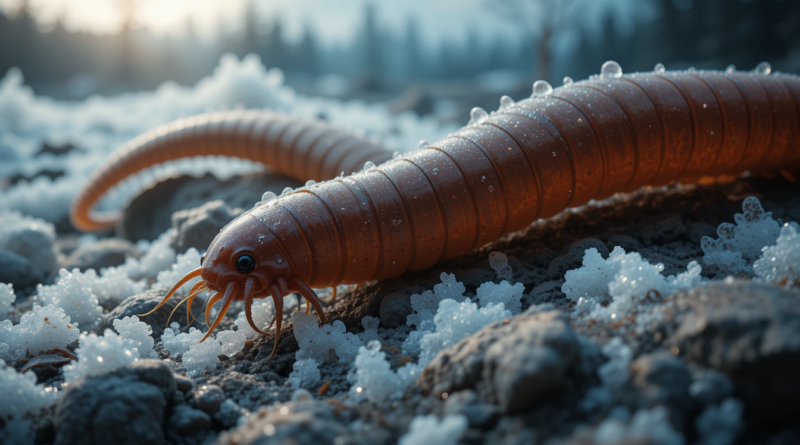Ancient Life Awakens from Siberia’s Frozen Archive
In the windswept tundra of northeastern Siberia, where temperatures plummet to bone-numbing extremes and the ground remains locked in permafrost for millennia, scientists have uncovered one of the most extraordinary biological discoveries of our time. Deep beneath the frozen earth, encased in ice older than human civilisation, microscopic creatures have been waiting—not dead, but dormant—for nearly half a century of millennia.
In 2023, researchers announced they had successfully revived a microscopic roundworm that had been frozen in Siberian permafrost for an astonishing 46,000 years—a time when woolly mammoths roamed the Earth and Neanderthals still walked amongst our ancestors. This isn’t science fiction; it’s a testament to life’s remarkable ability to endure in the most inhospitable conditions imaginable.
The Discovery That Defied Death
The story begins in the remote Kolyma River region of Siberia, where international teams of researchers have been systematically extracting and examining permafrost samples. The nematode was discovered approximately 130 feet deep within the permafrost, nestled inside what was once a burrow inhabited by Arctic gophers during the Pleistocene epoch.
What makes this discovery particularly remarkable isn’t merely the age of the specimen, but what happened next. After careful thawing and cultivation in laboratory conditions, the microscopic worm didn’t just survive—it thrived. The female roundworm began reproducing in a laboratory dish, effectively starting a new lineage after its 46,000-year slumber.
The creature, now christened Panagrolaimus kolymaensis after its discovery location, represents an entirely new species previously unknown to science. This groundbreaking research, published in the prestigious journal PLOS Genetics, has not only expanded our understanding of life’s resilience but also opened new avenues for studying survival mechanisms in extreme environments.
The Science of Suspended Animation
How does a complex multicellular organism survive for tens of thousands of years? The answer lies in a remarkable biological process called cryptobiosis—literally meaning “hidden life.” During cryptobiosis, organisms enter a state of suspended metabolism when environmental conditions become unfavourable, executing a sophisticated combination of genetic and biochemical pathways that enable survival for prolonged periods.
Dr. Teymuras Kurzchalia and his team at the Max Planck Institute for Molecular Cell Biology and Genetics in Germany led the genetic analysis of these remarkable survivors. Their research revealed fascinating parallels between the ancient Siberian worm and Caenorhabditis elegans, a commonly studied laboratory nematode that serves as a model organism for biological research.
Despite being separated by millions of years of evolution, Panagrolaimus kolymaensis appears to share a remarkably similar survival toolkit with its more contemporary cousin. Both species utilise comparable genetic mechanisms to enter their dormant state, suggesting that the ability to survive extreme conditions through cryptobiosis is a fundamental and ancient survival strategy.
The Molecular Mechanics of Survival
The research team’s experiments revealed intricate details about how these organisms prepare for their extended hibernation. When subjected to mild dehydration before freezing, the worms increased their production of a sugar called trehalose, which appears to play a crucial role in protecting cellular structures during the cryptobiotic state. This preparation phase proved essential—worms that underwent this process showed significantly improved survival rates when exposed to temperatures of −80°C.
The genome sequencing of P. kolymaensis has provided unprecedented insights into the molecular basis of extreme survival. Researchers identified specific genes involved in the cryptobiotic process, many of which have counterparts in other organisms known for their resilience to harsh conditions. This genetic analysis suggests that the mechanisms for surviving extreme environments may be more widespread in nature than previously thought.
A Window Into Ancient Ecosystems
The implications of this discovery extend far beyond the remarkable survival story of a single worm. These organisms serve as living time capsules, preserving genetic information from ecosystems that existed during the Late Pleistocene period. By studying their genomes and biological processes, scientists can gain insights into how life existed and adapted during dramatically different climatic conditions.
The permafrost regions where these worms were discovered represent some of Earth’s most extensive natural archives. Permafrost—ground that remains frozen for more than two years consecutively—underlies nearly one-quarter of the land in the northern hemisphere, with the deepest layers extending a mile into the Earth and the oldest sections being more than 600,000 years old.
The Broader Implications of Permafrost Research
While the revival of ancient worms captures the imagination, it also highlights critical environmental concerns. As global temperatures rise, the Arctic is warming at a rate four times faster than the rest of the planet, causing widespread permafrost thawing that could potentially release long-frozen organic matter, including viable bacteria and viruses.
The scientific community is increasingly concerned about what else might emerge from thawing permafrost. Research conducted as part of the ESA-NASA Arctic Methane and Permafrost Challenge has revealed that rapidly thawing permafrost could potentially release antibiotic-resistant bacteria, undiscovered viruses, and even radioactive waste from Cold War-era nuclear installations.
The potential risks are not merely theoretical—in 2016, a thawed permafrost event in Siberia released anthrax spores that caused an outbreak affecting both livestock and humans, the region’s first such incident in 75 years. This incident underscores the need for continued research into permafrost ecosystems and their potential impacts on global health and environmental stability.
The Future of Cryptobiosis Research
The successful revival of P. kolymaensis has opened new research frontiers in astrobiology, climate science, and medical research. Understanding the mechanisms that allow organisms to survive in extreme conditions for extended periods could have profound implications for everything from organ preservation techniques to the search for life on other planets.
NASA and other space agencies are particularly interested in cryptobiosis research as they plan for long-duration space missions. The ability to induce reversible suspended animation could revolutionise space travel, allowing humans to survive journeys to distant planets. Similarly, medical researchers are exploring applications in organ transplantation and treatment of degenerative diseases.
Lessons from the Deep Freeze
The story of the Siberian worms challenges our understanding of life’s limits and possibilities. Permafrost serves as a reservoir of mostly uncharacterised microorganisms and viruses, many of which could be viable, though our limited knowledge means we lack the basis to judge whether they pose risks to humans, animals, and plants.
As we continue to study these remarkable survivors, we’re gaining invaluable insights into the fundamental principles of life, adaptation, and survival. The research also emphasises the importance of preserving permafrost regions not just for climate stability, but as repositories of biological information that could prove invaluable for future scientific discoveries.
The ancient worms of Siberia remind us that life is far more resilient and adaptable than we ever imagined. In an era of rapid environmental change, understanding these mechanisms of survival could prove crucial for both preserving existing ecosystems and preparing for an uncertain future. As climate change continues to alter our planet’s frozen archives, each discovery becomes more precious—and more urgent.
The Lazarus worms have awakened from their millennia-long slumber to teach us about the extraordinary tenacity of life. Their story is far from over; indeed, it may be just beginning to unfold the secrets they’ve carried from a world we can barely imagine to one we’re still struggling to understand.
The research on Panagrolaimus kolymaensis continues at laboratories worldwide, with scientists working to unlock further secrets of cryptobiotic survival. As permafrost regions face unprecedented warming, the race is on to document and understand these ancient biological treasures before they’re lost forever.
We’d love your questions or comments on today’s topic!
For more articles like this one, click here.
Thought for the day:
“It is strange that the years teach us patience; that the shorter our time, the greater our capacity for waiting.” Elizabeth Taylor



